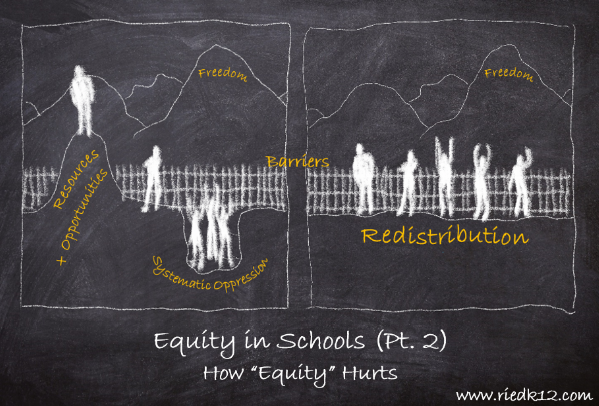Equity in Schools (Part 2): How “Equity” Hurts
Read Equity in Schools Part 1 here
In part one of this series we discussed common misconceptions that lead to misuses of the term equity. It’s not that these misconceptions are malicious, or even inherently inequitable; however they can, and often times do, distract from the ultimate goal of creating an equitable world. In this piece we examine the potential harm that comes from misunderstanding equity.
There is an article that circulated in education circles that cited three types of microaggressions teachers commit. The list included: addressing students for wearing hats and hoodies, sleeping in class, and cussing. The article is a perfect example of how well-intentioned white folks take a slice of equity truth to harmful and ultimately racist conclusions.
What happens in situations like these is that white teachers resonate with a piece of truth such as “empathy over consequences” or "purpose over power" and because whiteness has been so internalized, and is so ubiquitous, these truths of equity are co-opted and actually leveraged to perpetuate whiteness. For example, the article cited earlier argued that a student sleeping in class should not receive a consequence but rather be met with empathy because of a student’s potential background and access to a good night's sleep. There is truth in that we should always lead with empathy. And empathy should always help inform policy and process. However, it is stereotypical to suggest that students of color, or students from lower SES backgrounds come from households that don’t value a good night's sleep or prioritize that for their children. Consequently, in the name of "equity", by electing not to hold a student to the basic bar of ‘being awake in class’ dramatically withholds access to opportunities and resources later in life for said student.
This line of thought is present throughout education worldviews: our students have it so rough they cannot do x, y or z. This is dangerous deficit thinking which results in what Lisa Delpit discusses in her work Other People’s Children where students of color are prevented from learning the necessary customs, skills, and ways of being required for navigating the social landscape. This is a particularly attractive practice for white teachers who convince themselves they are acting in an equitable manner while the impact of their actions further entrenches inequities.
Furthermore this inability to do the work of internalizing equity results in the dehumanization of students of color and poor students. This dehumanization comes via romanticizing and idolizing young people. In this world if a student puts their head down, cusses, or wears a hoodie it is because (a) they are experiencing hardships that are unthinkable (b) their families don’t share values with the school and/or (c) they are incapable of acting in any other way because of their circumstances. Never, in this worldview, are young people simply being young people, testing boundaries, or trying to get out of something in the moment. This worldview strips young people of their humanity and leaves teachers incapable of building authentic relationships with students and their families because it pathologizes poverty and other.
Instead of these generic, flattened, and superficial prescriptions for equity we would do better to sharpen our own critical lens, understand how whiteness keeps us from what Cornel West calls the “funk” inherent in genuine relationships and community, and cultivate genuine culture with students and families that orients towards justice, redistribution and liberation.
Equity in Schools Part 3: Covers how to use an understanding of equity to obtain equitable outcomes.
Ian McLaughlin
